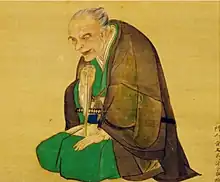
Ono Motohiro (小野職博, 1729–1810), also known as Ono Ranzan (小野蘭山), was a Japanese botanist and herbalist, known as the "Japanese Linnaeus".[1]
Ono's real surname was Saeki (佐伯); his adult given name was Motohiro (職博).[2] Ranzan (蘭山) became his art name and Ibun (以文) his Chinese style courtesy name.[3][2]
He was born in Kyoto to a courtly family, and studied in his youth under Matsuoka Shoan.[2] In 1754, he opened a school of botanical pharmacology (pharmacognosy) which enjoyed considerable success, with over a thousand pupils enrolling.[4]
One student who studied under Ono at this time was Kimura Kenkadō. In 1799, he was given a post at the Seijūkan, the country's major government medical school in Edo.[2] Here he worked extensively on a translation into Japanese of Rembert Dodoens' herbal guide, the Cruydeboeck. Ono was familiar with Western herbalism (making use of the work of Johann Wilhelm Weinmann in his translation) and had studied both traditional Chinese medicine and Western medicine as well.[5][6] Some of Ono's own works on Japanese botany were translated by the French botanist Ludovic Savatier.[7]
In the early years of the nineteenth century, Ono travelled around Japan gathering information on botanical remedies, which culminated in his most important literary work, the Honzō Kōmoku Keimō (本草綱目啓蒙, "Dictated Compendium of Materia Medica"), which was edited by his botanist grandson Ono Mototaka,[8][9][10] and first published in 1803–1806.[2][11] It was a piece on natural history espousing viewpoints independent from China's Honzō Kōmoku (the Bencao Gangmu).[3] Despite Ono's knowledge of Western and Chinese botany, this was one of the first books in the Japanese natural sciences to advocate experimentation and research rather than reliance on the Chinese Classics.[12] He also co-authored the floral work Kai 花彙. Ono never married, but fathered a son with one of his household servants.[2]
After his death in 1810 he was interred at Asakusa; however, his remains were moved to Nerima in 1927 after the graveyard was damaged in the Great Kantō earthquake.[13] The barberry species Ranzania japonica was named in his honour.[14]
Editions
- Ono, Ranzan (1844), Ono, Mototaka (ed.), Jūshū honzō kōmoku keimō (in 35 vols.) 重修本草綱目啓蒙, Hishiya Kichibē
References
- ↑ Kimura, Yojiro (1979), "Thunberg, the founder of modern botany in Japan", Symbolae botanicae Upsalienses, 22 (4): 15, ISBN 9789155406486
- 1 2 3 4 5 6 Beerens, Anna (2006), "Ono Ranzan", Friends, Acquaintances, Pupils and Patrons: Japanese Intellectual Life in the Late Eighteenth Century : a Prosopographical Approach, Amsterdam University Press, ISBN 978-90-8728-001-7
- 1 2 "Ono Ranzan" 小野蘭山, Asahi nihonrekishi jinbutsu jiten 朝日日本歴史人物事典, 1994 via Kotobank
- ↑ Takeuchi, Melinda (1 March 1994). Taiga's True Views: The Language of Landscape Painting in Eighteenth-Century Japan. Stanford University Press. p. 117. ISBN 978-0-8047-2088-5.
- ↑ Vande Walle, Willy; Kasaya, Kazuhiko [in Japanese] (1 January 2001). Dodonaeus in Japan: Translation and the Scientific Mind in the Tokugawa Period. Leuven University Press. p. 199. ISBN 978-90-5867-179-0.
- ↑ Walker, Brett L (1 November 2009). The lost wolves of Japan. University of Washington Press. p. 33. ISBN 978-0-295-98993-8.
- ↑ Popov, Konstantin Mikhaĭlovich; Institut narodov Azii (Akademii︠a︡ nauk SSSR) (1969). Japan: essays on national culture and scientific thought. Nauka Pub. House, Central Dept. of Oriental Literature. p. 197.
- ↑ Ono (1844).
- ↑ Nemoto, Soyoko (1984–1994), "Ono Ranzan" 小野蘭山, Nipponica 日本大百科全書(ニッポニカ), Shogakukan via コトバンク
- ↑ "Ono Ranzan" 小野蘭山, Sekai daihyakka jiten 世界大百科事典 (2 ed.), Heibonsha via コトバンク
- ↑ Fukuoka, Maki (15 August 2012). The Premise of Fidelity: Science, Visuality, and Representing the Real in Nineteenth-Century Japan. Stanford University Press. p. 205. ISBN 978-0-8047-8462-7.
- ↑ Goodman, Grant K. (4 July 2013). Japan and the Dutch 1600-1853. Routledge. p. 171. ISBN 978-1-136-83173-7.
- ↑ "Japan: A portrait of the Japanese botanist and herbalist Ono Ranzan (1729–1810), 1810. Painted by Tani Bunchō (1763-1841)". Pictures from History. Retrieved 15 May 2015.
- ↑ "Notes and News". Botanical Gazette. 13 (11): 304. Nov 1888. doi:10.1086/326357. JSTOR 2994806.